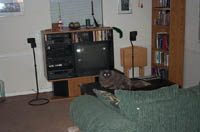
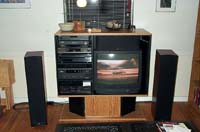
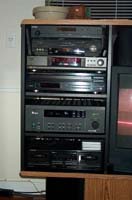
As part of the move from our old house (which I bought in 1999 before we were married) to our new, larger home in January 2004, I took some time to straighten out some of the random assortment of pictures floating around the site. As it turns out, there were a bunch of them. When I moved into the old house, I had a pretty simple home theater setup, and the process of packing and moving everything reminded me of how much I changed in just a few years. I decided to consolidate the assortment of home theater pictures and notes that had accumulated on the web site over the previous couple years along with some other out-of-date notes that were sitting around.
Everybody's move into home theater varies. In some cases, people who get into home theater start out with little more than a VCR hooked up to their TV and a "boom box" CD player. Other people grow into it in stages, starting with perhaps a stereo system (receiver, CD player, maybe a tape deck) that often isn't even associated with a TV. I fall into the latter category. After my freshman year of college, I decided to replace the Panasonic shelf system (tuner, dual tape deck, and turntable with a separate Pioneer 6-disc CD changer hooked up to it) that I'd used for five years with something more. The result was the beginning of my home theater hobby, especially when I added a small TV and a Super-VHS VCR two years later. Listed below are snapshots of the two systems that led me to where I am now, along with a record of some of the changes that my home theater system went through while set up in our old house.
When I moved into the house in April 1999, I still had my Dolby Pro-Logic setup (Yamaha receiver, Bose speakers, Mitsubishi 27" TV, Panasonic A310 DVD player). Starting in mid-2000, I began thinking about making a change or two to the home theater. I was interested in finding out what all the fuss was about with Dolby Digital, but there was no upgrade route to Dolby Digital with my Yamaha receiver. The result was the purchase of an Outlaw Audio Model 1050 receiver (now retired, with a successor expected in late 2004). That upgrade generated a strong desire to replace my Bose speakers (Acoustimass 7 and Model 100 surrounds; see my comments about Bose at the end of this page before actually thinking about buying any of your own), which resulted in the arrival of a set of Paradigm Reference speakers (Studio/60 v2 mains, Studio/CC v2 center, and a trio of Studio/ADP v2's for surrounds and a single surround back channel) in the spring of 2001. At around the same time, I upgraded to digital cable and replaced my Harmon/Kardon FL-8300 CD changer with a Yamaha CDC-775 changer. My research during these upgrades (particularly the Model 1050) led me to write down some basic notes as an introduction to home theater and post them on my site; those notes have since evolved into the Basics of Home Theater section of the site. The pictures below are from spring 2001, except for the first picture which actually shows the system as it was almost immediately after the Model 1050 was installed (Model 1050, Harman Kardon FL-8300 CD changer, tape deck, SmarkLink cable box, DVD-A310, VCR, Mitsubishi TV, and Bose speakers).
I started down the road to separates in July 2001 when I added an Outlaw Audio Model 750 amp (which, like the 1050, is no longer in production -- replaced by the 770 and 755). At the same time, I started some serious investigation into interconnects (as discussed a bit here, near the end of the page).
Once I was into separates, it was only logical to swap the Model 1050 out for a true pre/pro. In preparation for that, I added a second amp (a used two-channel Parasound HCA-800) in late 2001, then in early 2002 moved the VCR to make more room in the equipment rack in preparation for the arrival of Outlaw's Model 950 pre/pro. Along the way, I even picked up a Sega Dreamcast game console as they were clearing out the last of the warehouses (my first game console since the Atari 2600).
In April 2002, The Model 950 arrived, replacing the 1050 (which had previously replaced the Yamaha). Less than a month later, I also replaced the A310 with a DVD-RA60 DVD-Video/DVD-Audio player. The 950 was a major upgrade for the system. It was also the first piece of equipment that I wrote a review for.
By late spring of 2002, the only component completely missing from my system was a subwoofer; an SVS 25-31PCi changed that in August 2002. It would be the last upgrade for nearly a year.
In the summer of 2003, I made the last two changes to the system before we decided to move: an MX-500 universal remote and a Panasonic DMR-E80 DVD recorder. The MX-500 was the fifth universal remote to sit on the coffee table, preceded by the Model 950's re-badged SL-9000, a Sony RM-AV2100, the Model 1050's Catalyst 48 remote, and the Yamaha's learning remote. The Yamaha CD changer was pushed out of the equipment rack when the recorder arrived, and I began using the RA60 as my CD transport. The SVS had also moved by then and the Dreamcast picked up some storage for games, as can be seen in the pictures below.
There are also a couple pictures of the CD case I bought in 2001, showing the growth of the CD collection over the course of two years or so.
When we put the house on the market in December 2003, very little of the system remained as it was when I moved in in April 1999. The Yamaha receiver had been replaced by an Outlaw 1050, which was itself replaced by an Outlaw Model 950. The Harman Kardon CD changer developed a carousel problem (which went away when I removed it from the rack -- apparently it's a heat issue) and made way for a Yamaha changer, which was in turn recently pushed out of the rack by the DVD recorder. The tape deck got kicked out by the amp. The Bose speakers were happily banished by the Paradigm Reference speakers and have all be shuffled away with some help from eBay. The Panasonic DVD-A310 DVD player was replaced by a Panasonic DVD-RA60 player that added DVD-Audio. The amplifiers, Panamax MAX5100, Dreamcast, and DMR-E80 DVD recorder were new additions to the system along the way. Even the old SmartLink cable box that I had when in 1999 was replaced by a Scientific Atlanta digital cable box, and that box was traded out for a Pace Micro DC-510 box in 2003 because the Pace box offered digital audio output from every channel. In the end, the only components in the system that hadn't changed were the old VCR (hidden from view inside the entertainment center and relegated to archiving duty with the DVD recorder) and the TV (which is slated for replacement in the not too distant future). At the time of our move, the system had reached a state where I was very pleased with it, although I knew that I wanted to upgrade a few components (most notably the television).
In the new house, the upgrades continued slowly but steadily throughout 2004. During the move, the third Studio/ADP rear surround speaker was retired and a pair of Axiom Audio M3ti bookshelf speakers added as surrounds (the pair of Studio/ADP's moved from side surround to rear surround duty due to some installation restrictions in the new house). A few months later, we replaced the old entertainment center with a much nicer unit, which afforded us room for a larger TV. Over the course of the spring, the SVS 25-31PCi was replaced with an Outlaw Audio LFM-1 sub and the 27" Mitsubishi TV was replaced by a 32" Zenith HDTV. At the same time, the Pace DC-510 digital cable box was traded in for a Pace DD-550 HD digital cable box.
The Panasonic DVD-RA60 was replaced by a Yamaha DVD-S1500 universal player in September 2004, and the Parasound HCA-800 Mk. II amp (which was discovered to have a problem in the right channel after our move) was replaced by a pair of Outlaw Audio Model 200 monoblocks in late November 2004. The monoblocks now drive the Studio/60's while the Model 750 handles the center and all four surrounds. We also decided to pick up a camcorder as a Christmas gift to each other. At that point, I thought that I had the system upgrades done for the foreseeable future. Instead, 2005 brought a series of upgrades: an Outlaw Audio Model 990 surround processor in place of the Model 950, an OPPO Digital OPDV971H upscaling DVD player that serves alongside the S1500, and a Home Theater Master MX-700 remote in place of the MX-500. Between those most rewarding upgrades and the arrival of our daughter Kate in February 2005, the system reached a point where I saw no need for further upgrades to improve performance. You might say that the system in place in May 2005 was the conclusion of an upgrade cycle that started in October 2000 with the addition of an Outlaw Model 1050 Dolby Digital/DTS receiver.
After college, I replaced the receiver with a Yamaha RX-V690 Dolby Pro-Logic receiver. I also replaced the speakers with Bose Acoustimass 7 for the mains and center channel and Bose Model 100 for the surrounds. The CD player was upgraded a few months after the receiver and speaker upgrades. The 19" TV from the basic system above stayed around for about a year before being replaced with a Mitsubishi CS-27309 27" television (picture-in-picture, and most importantly an S-video input). The DVD player was actually not added until almost two years after the Yamaha was bought (November 1998, to be exact), but is included below because it was the component that really made the system into a serious and regularly-used home theater.
Display: Mitsubishi CS-27309 27" stereo TV, one rear S-Video/composite audio-video input, one front composite audio-video, picture-in-picture. This is a TV that you won't find at Best Buy or Circuit City -- Mitsubishi doesn't sell through the large chains. It's worth tracking down, however, because the picture quality with a good signal is excellent. It's worth noting, however, that Mitsubishi seems to have shifted their focus away from small televisions (small in this case being under 40") and now only make rear-projection sets.
VCR: Panasonic PV-S4566 Super-VHS HiFi VCR. My first (and so far only) VCR.
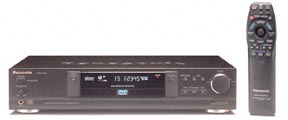 DVD Player: Panasonic DVD-A310, internal Dolby Digital decoder, Dolby Digital and DTS digital outputs (coaxial and optical), two composite video outputs, one S-video output, one component video output, two analog stereo outputs. A product of the second generation of DVD players, the A310 was a great piece of equipment in its day. The current generation of Panasonic players are even better, though.
DVD Player: Panasonic DVD-A310, internal Dolby Digital decoder, Dolby Digital and DTS digital outputs (coaxial and optical), two composite video outputs, one S-video output, one component video output, two analog stereo outputs. A product of the second generation of DVD players, the A310 was a great piece of equipment in its day. The current generation of Panasonic players are even better, though.
Receiver: Yamaha RX-V690, 80Wx3, 25Wx2 to surrounds, Dolby Pro-Logic decoding. When this receiver was new, Dolby Digital was expensive and the need for it was limited -- DVD was about to debut, and LaserDisc had a limited user base. For a Pro-Logic and two-channel receiver, it does a great job. Five-way binding posts on the main speaker connections and spring clips for the center and surround speakers.
CD Player: Harman/Kardon FL-8300 five-disc carousel CD changer, analog stereo and coaxial digital outputs. When I pulled out the old Pioneer changer and installed this player, the effect it had on my CD's was immediate and impressive. A very good upgrade, although I have since had some intermittent problems with the player resetting discs slightly "off" in the carousel. It seems to be largely due to overheating, since the resetting problem stopped when it was moved to the guest room with the Yamaha RX-V690 where there was less equipment and more ventilation. Based on this and on reviews I've seen on the Internet, I'd be a little wary of Harman/Kardon products, mainly due to reliability concerns.
Tape Deck: Pioneer CTW-301 dual-deck, no auto-reverse (still around, but rarely used).
| Main and Center Channel Speakers: Bose Acoustimass 7 system, composed of a bass module (passive subwoofer) and three cube speaker arrays. The bass module contains the crossovers that send the mid-range and treble on to the cubes, as well as 5.25" drivers to provide the bass (the current Acoustimass 10, which is apparently identical to the Acoustimass 7 except for two additional cubes for surround channels, uses three of these drivers, but the Acoustimass 5 - which the Acoustimass 7 was a spin-off of - uses only two 5 1/4" speakers). The cubes are two-piece, with the upper and lower speakers able to be pointed in different directions. Each half contains a 2.5" paper cone speaker. I used these speakers for four years before replacing them in early 2001, and sold them in November 2001. See my comments at the end of my home theater speaker guide for my feelings on these. |
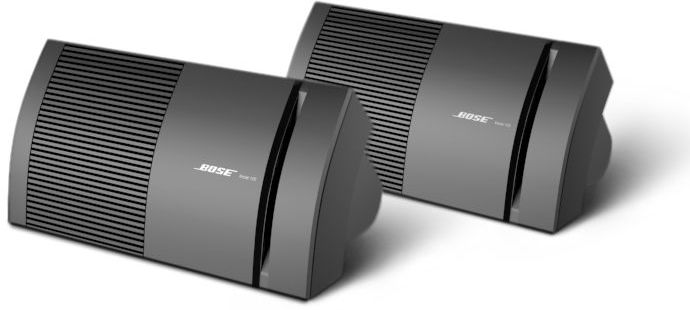 Surround Speakers: Bose Model 100 speakers, each with a 4 1/2" speaker. They have a pretty sleek look, with the wedge-shaped style and the unusual slotted port on the end. Amazingly enough, the 4 1/2" speaker has a composite cone, rather than the paper cones that are used in most Bose speakers. They sound better than the old Garrard bookshelf speakers and they came with mounting brackets so I could mount them to the wall when I moved into my house. They do a fairly decent job as surrounds, but there are better speakers available for the same price. If you're on a budget and can get them for under $100, they may be worthwhile. If you're going to spend $150 on surrounds, check out Paradigm or some other manufacturers who have some budget speakers (Paradigm Cinema or Micro speakers, for example).
Surround Speakers: Bose Model 100 speakers, each with a 4 1/2" speaker. They have a pretty sleek look, with the wedge-shaped style and the unusual slotted port on the end. Amazingly enough, the 4 1/2" speaker has a composite cone, rather than the paper cones that are used in most Bose speakers. They sound better than the old Garrard bookshelf speakers and they came with mounting brackets so I could mount them to the wall when I moved into my house. They do a fairly decent job as surrounds, but there are better speakers available for the same price. If you're on a budget and can get them for under $100, they may be worthwhile. If you're going to spend $150 on surrounds, check out Paradigm or some other manufacturers who have some budget speakers (Paradigm Cinema or Micro speakers, for example).Cabling: The cables were slowly upgraded from manufacturer-provided and Radio Shack interconnects to be almost entirely Monster Cable wiring (Monster Cable interconnects on everything except the tape deck, Monster Cable S-video from the DVD player to the TV, Monster Cable composite video from the VCR to the TV, white Monster XP surround speaker cable, and Monster Cable speaker cable to the Acoustimass 7). See the section here on cabling for more on what cables you might want to invest in.
This is what I had in college. It is a bare-bones two-channel system. For the first few years, it was purely a music system. The TV and VCR arrived later in college to provide limited television and movie watching.
Display: Panasonic 19" mono TV, RF coaxial connection only. Cheap, but effective for cable TV and VCR viewing and small enough to easily take with you when you move (a plus for a college student). My parents have been using it since 1998 as a replacement for a TV that died. Still works fine, and it even has a DVD player connected to it now.
VCR: Panasonic PV-S4566 Super-VHS HiFi VCR. This is a very nice VCR, with support for Super-VHS tapes and S-video input and output.
Receiver: Pioneer VSX-401 receiver, two-channel with no video inputs. Like the TV, it was cheap but effective. After three or four years, it began having problems with the tuner and with accepting input from the remote control. It spent a few years in storage, served as a surround back channel amp for a month or so until I found a used Parasound amp for that, and finally ended up in a yard sale back around 2002.
CD Player: Pioneer six-disc CD changer, magazine-type. I passed this changer along to my mom, who still uses it (along with a really old Panasonic tuner/tape deck/turntable shelf system that I bought in 1988). It was actually the second Pioneer CD changer that I owned; the first (purchased in 1989) was almost identical, but the magazine feed mechanism and some other parts gave out around 1994.
Tape Deck: Pioneer CTW-301 dual-deck, no auto-reverse. Useful for copying CD's to tape so I could listen to them in the '87 Ford Escort (which I chose not to put a CD player in because it would have doubled the car's value). These days, it is hooked up to the computer for copying tapes to CD. It doesn't see much use.
Speakers: Garrard bookshelf two-way speakers. They were cheap, and they were small. Unfortunately, after listening to other equipment, I came to realize that they sounded just like what they are: cheap, small speakers. They joined the VSX-401 in the yard sale.